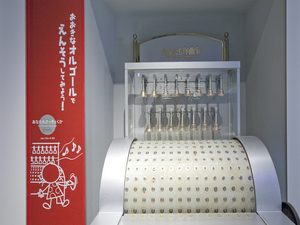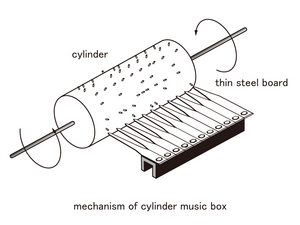Nagoya City Science Museum
TOP > Exhibition Guide > Keyword Search > Starting with "M" > music box > You Are the Composer
You Are the Composer



Purpose of Exhibition
This has the same mechanism as a music box, and it's an exhibit in which a bell rings.
In the big cylinder of the exhibit, nails are built in regularly. Rotating the cylinder, pins snap the arms connected to the hammers, and the hammers hit the bells. Depending upon the cylinder rotation, they hit the bells in turn, and music is played. Please observe the way the bells ring. In this exhibit, when the red-marked pin heads stand out, "Amaryllis" is played. When the blue marked pin-heads stand out, "The Sea" is played. If you change to different kinds of pins, you can compose your own music. Try composing your music freely. By the way, the bells of this exhibit are almost of the same size. You can generate sounds from high-tone to low-tone because of the different thickness of the bells, This exhibit is one of the "Natsukashino Tenji (Exhibition from a Good Memories)" , produced in 1992.
Additional Knowledge
The word orugoru is the Japanese name for music box. The music box was brought into Japan in the late Edo period, in 1852. They misunderstood the wooden-box in which the sound generates as an orugeru instead (organ). Orugeru was turned into a dialect and became the name of the organ. In English, it is called a music box or a musical box.
We would say that the history of the music box started from a device in which several bells ring automatically at church. This device structure was just the same as the one in the exhibit. It's not manual, but the force of the weights automatically weighs down the cylinder.
In 1796, a Swiss man, Jean-Henri Fabre, invented a mechanism in which melody was played by popping thin boards made out of different sheets of steel planted (comb teeth) in a metal cylinder.
The spring power was utilized for the rotation of the cylinder. It is believed to be the first form of music box that everyone is familiar with. (Cylinder music box) Afterwards, comb teeth were made out of a sheet of steel, and on the opposite side of the comb-like steel, weights are placed. A low, tremolo-like sound can be generated, upon which more improvements were made. In addition, with one cylinder, several melodies are recorded, drums and bells are also incorporated in some music boxes.
In 1885, the disk music box was invented, which uses disc protrusion on the opposite side instead of a cylinder. It was invented by a German, Paul Lochmann.
The cylinder pins needed to be put in manually, therefore it was very expensive work. But, disc protrusion could be mass-produced by stamping. Furthermore, it was easy to exchange with another disc plate. Automatic selection by inserting coin was also possible, and this invention became popular for not only familial use but also businesses.
Article by Keiko Ishida, curator
